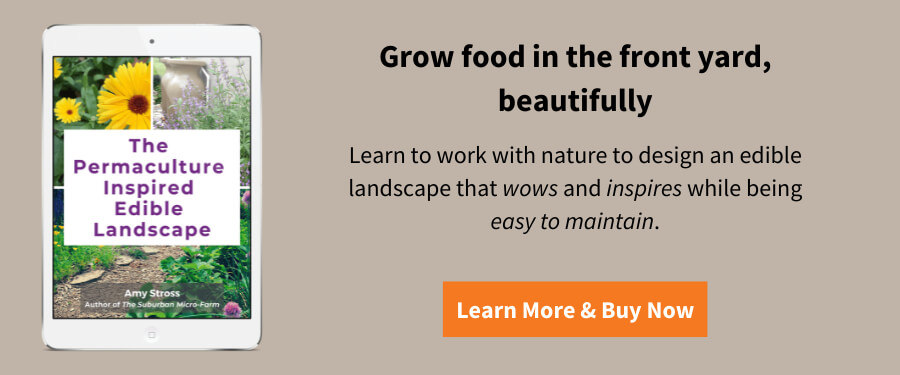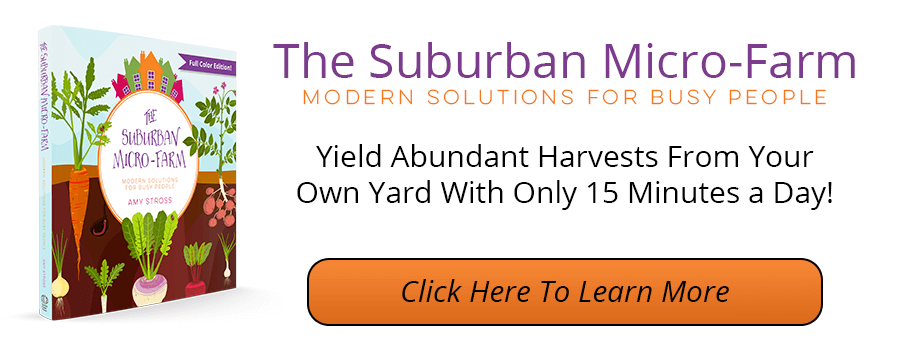There are oodles of herbs that transform into homemade healing remedies. Here are a few of my favorite herbs for the medicine garden that are easy to grow and contain valuable medicinal properties.

This page may contain affiliate links. Please read my disclosure for more info.
I am not a doctor and the FDA has not evaluated the following claims about the traditional and medicinal benefits of herbs.
Growing a Medicine Garden
The number of herbs that can be grown and used for their medicinal benefits is infinite, so it would be impossible to list them all here. Ask 50 gardeners what their favorite medicinal herbs are, and you’ll get 50 different answers!
The following are my eight favorite herbs for the medicine garden that I enjoy growing for their safe and gentle healing effects, used in poultices, salves, tinctures, elixirs, vinegars, and more.
The following are eight of my favorite medicinal herbs.
#1: Comfrey (Symphytum x uplandicum)
Comfrey has been used to promote the healing of acne, broken bones, bruises, scrapes, and sore muscles. Meanwhile its flowers attract a variety of pollinators.
Russian comfrey (Symphytum x uplandicum) is preferable to true comfrey (Symphytum officinale) for the medicine garden because its seeds are sterile and, therefore, will not self-seed around the garden. It grows in USDA growing zones 3-9.
To plant Russian comfrey, purchase live root cuttings and plant them two feet apart as early as four weeks before your spring frost date, and until four weeks after your fall frost date. Comfrey is a perennial that comes back every year.
It prefers rich, moist soil in a well-drained spot with full sun or partial shade.
- Buy: Russian comfrey roots
- Learn: Growing Comfrey in the Permaculture Garden
- Make: Knitbone Salve with Comfrey
Want all the benefits of a comfrey salve but don’t have time to make it yourself? Here’s my favorite source for high-quality, farm-grown and handmade herbal salve.

Comfrey in bloom
#2: Dandelion (Taraxacum officinale) in the Medicine Garden
Dandelion has been shown to support healthy liver and kidney function, supports healthy blood pressure, and encourages the healing of skin ailments like acne.
It sounds odd to plant dandelion in a medicine garden since it is so readily available as a weed. However, it often populates areas where heavy foot traffic compacts the soil, and harvesting safely in those areas is questionable. It grows in USDA growing zones 3-10.
Dandelion seeds are actually available for purchase. These culinary varieties grow larger leaves and thicker roots. Sow seeds 1⁄4-inch deep outside, four inches apart, two weeks before your frost date. Dandelion is a perennial plant.
It prefers well- drained soil with full sun or partial shade. If you produce more than you can use, take heart that dandelion leaves go for a high price to culinary chefs.
- Buy: Dandelion seeds
- Learn: 5 Weeds You Want in Your Garden
- Make: Dandelion Body Butter. Check out Homemade Products for Your Skin, Health & Home Using Homegrown Herbs.
Want to grow fruits, vegetables, and herbs in your front yard landscape without sacrificing curb appeal? Check out my mini guide, The Permaculture Inspired Edible Landscape.
#3: Echinacea (Echinacea purpurea)
Echinacea is used as an immune stimulant, and the tea is often gargled for a sore throat. Add beauty and function to your medicine garden!
This beautiful purple coneflower grows in USDA growing zones 3-9. Sow seeds in the fall in a well-prepared bed. Or transplant seedlings outside during the week of your spring frost date, two feet apart. Echinacea is a hardy perennial and prefers full sun or partial shade in rich soil.
- Buy: Echinacea seeds (Like all perennials, seeds germinate and grow slowly. Research ‘growing perennial herbs from seed’ before sowing.)
- Learn: When Weeds are Good
- Make: Elderyberry Syrup with Echinacea and Goldenseal by Grow Forage Cook Ferment
#4: Fennel (Foeniculum vulgare) in the Medicine Garden
Herb fennel stimulates appetite, support healthy digestion, and is gargled as a tea for a sore throat, which makes it an excellent candidate for the home medicine garden.
This beautiful, yellow flowering herb grows in USDA growing zones 3-10; it’s a perennial in zones 5-10 and an annual in northern climates. Sow seeds 1⁄4-inch deep, 16 inches apart, two weeks before your frost date. It readily self-seeds. Fennel needs rich soil in a sunny location.
TIP: HARVESTING FENNEL SEEDS
Harvest fennel seeds at the end of summer so the plants don’t set seed everywhere. Cook with the seeds, chew on them after meals to help with digestion, and give them away to your gardener friends for planting! If you have an out-of-control fennel patch, chickens enjoy the forage.
- Buy: Fennel herb seeds
- Learn: Grow it under fruit trees! How to Build a Fruit Tree Guild
- Make: Set out a bowl of fennels seeds after a meal. Chewing them as a digestive aid is a tradition from India, where they are served with square crystals of sugar, according to The Penguin Food Guide to India.
#5: Garlic (Allium sativum)
Garlic aids immunity, supports healthy blood pressure, and is traditionally used in remedies to eliminate common intestinal parasites. If you already grow garlic in your vegetable garden, then you’re one step closer to taking advantage of garlic’s medicinal properties.
It grows in USDA growing zones 3-9 and is planted in the fall. Plant garlic cloves five inches apart and two inches deep, with the pointed end facing up. Mulch the bed well and harvest in early summer.
It prefers rich, moist soil in a well-drained location with full sun or partial shade.
- Buy: Garlic bulbs for planting (my favorite variety)
- Learn: When to Harvest and How to Store Garlic
- Make: Garlic & Honey Fermented Cloves for cardiovascular and immune health by Nitty Gritty Life

Spring garlic growing in the edible landscape
#6: Lavender (Lavandula angustifolia) in the Medicine Garden
Lavender is another herb that is typically grown for its beautiful flowers and lovely scent.
Add medicinal properties to your list of reasons for planting it in the medicine garden! Lavender is traditionally used to support mental wellness, encourages germ-free environments, promotes healthy digestion, and corrects muscle tension.
It grows in USDA growing zones 5-9. Transplant seedlings outside, 15 inches apart, four weeks after your frost date. Lavender is a perennial that comes back every year.
It requires well-drained soil in full sun. Allow the soil to dry out in between waterings.
- Buy: Lavender plant (As with many perennial herbs, it can be tough to grow from seed.)
- Learn: See How Easily You Can Create an Edible Landscape
- Make: Lavender Dandelion Pain Relief Oil. Check out Homemade Products for Your Skin, Health & Home Using Homegrown Herbs.

Lavender is grown for its beautiful flowers, lovely fragrance, and medicinal qualities.
#7: Lemon Balm (Melissa officinalis)
Lemon balm supports headache relief, encourages stress relief and restful sleep, and supports relief from menstrual cramps. This herb has a place in all of my gardens, not just the medicine garden, since it aids healing soil in addition to its healing benefits to humans.
It grows in USDA growing zones 4-9. Transplant seedlings outside, 18 inches apart, four weeks after your frost date. Lemon balm is a perennial that comes back every year.
It requires rich, well-drained soil with partial shade from the afternoon sun.
- Buy: Lemon balm seeds (Reminder: Growing perennial herbs from seed will take patience.)
- Learn: See How Easily You Can Create an Edible Landscape
- Make: Take an herbal tincture with lemon balm at the first sign of a cold. Make a soothing salve with calendula and lemon balm.
Would you like to learn more about growing herbs for improving biodiversity, reducing maintenance, and increasing yield? You’ll find loads of information in my award-winning book, The Suburban Micro-Farm.
#8: Thyme (Thymus vulgaris) in the Medicine Garden
Thyme is used medicinally to support healthy lungs and respiratory system, and corrects fungal imbalances. This herb may have delightful, dainty flowers, but don’t let those fool you. This powerfully healing herb has earned its medicine garden badge.
It grows in USDA growing zones 5-10. Transplant seedlings outside, 12 inches apart, two weeks after your frost date. Thyme is a perennial that comes back every year.
It needs well-drained soil in a hot and sunny location. Allow the soil to dry out in between waterings.
- Buy: Thyme seeds (Be patient with germination for perennial herbs!)
- Learn: 6 Reasons to Grow Thyme
- Make: A Sage and Thyme Herbal Elixir for cold and flu symptoms

Common thyme in bloom
Herbs are incredibly rewarding to grow, whether you’re growing herbs in a kitchen garden, a medicine garden, or a pollinator garden.
What healing preparations have you made with herbs from your medicine garden?
READ NEXT:







Michael MooYin says
Hello Amy, love this site. My question for you is….how can I get someone to come design my land and help me with getting started. It’s hard to find someone that has experience in what they are doing….at a fair price…we not rich..lol. what should I do?
Amy says
You’ll have to see what designers in your area charge. Many will offer an initial consultation at no or low charge. But remember, they have earned their credentials and also need to make a living. So, see what they charge. Maybe it’s something you can afford. Or at least you know so you can begin saving for it. Depends on how important it is to you!
Antonia Wynn says
Hello Amy,
The information you have provided on your website have been very useful and informative. I really like how you’ve organized all your information. So I hope you can help me because I still have many, many, many questions. And presently, the question that I hope you can answer because I have spent countless hours searching, and the question is… “WHERE CAN I PLANT FENNEL?! Most sites basically say you can’t plant fennel anywhere. Then you have a couple sites that say you can plant near certain plants like Dill, &Wormwood. Then another site warns against planting anywhere near them. All these various contradictory information are sourced from extension offices of many states, and several different university articles, etc. It’s giving me a headache! None of these sites actually answer my question. And I am not the only one… perusing the comments below on some of these sites people ask the same question. In one of your articles you mentioned planted fennel as part of your fruit tree guild. I, and a million fennel loving people would like to know where you planted your fennel within your guild.
Also, if you ever build a small keyhole garden a good article to cover is how to arrange your crop. It’s a fairly recent garden technic I am currently using so information on planting arrangements is very limited. When I used square foot gardening, I was able to find tons example lay-out on what, and where plants can be planted. My Hexagon shaped garden looks a bit awkward.
Thank you!
Amy says
I would plant fennel anywhere you like, knowing that it’s a taller plant that needs space. I wouldn’t worry so much about whether it’s a companion or an antagonist to your other plants. They’ll all work out an agreement over time. I didn’t notice any adverse effects in my garden. Just be sure to harvest all the fennel seed or cut the flowerheads back before they go to seed, or fennel will take over the garden.
Christine says
Hi Amy, love your book and your newsletter! I want to know if you consult privately with people online, and I have a general question about fig trees. I don’t see anywhere what plants or polinators work best planting under or next to fig trees. I appreciate any feedback!